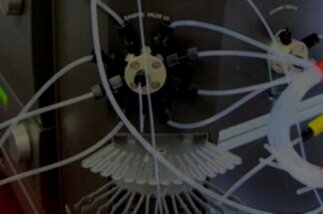
Service for ELx50™ & ELx405™ Microplate Washer models
You rely on your equipment. Your equipment should rely on ATG.
Every effort has been made to ensure that the ELx50™ Microplate Strip Washer and ELx405™ Microplate Washer models are extremely reliable and easy to use. Nevertheless, you could experience problems with the washer hardware, software, and / or accessories. Analytical Technologies Group specializes in the maintenance and repair of BioTek® Instruments, Inc. microplate washers. We also keep most replacement parts stocked, so that we can provide rapid service and minimize your instrument downtime. Preventative maintenance will keep your BioTek® Microplate Washer running smoothly with minimal downtime, but if you want to minimize your downtime even further, contact us about a service contract!
Tips for keeping your BioTek® Microplate in good working order:
Clean the manifold tubes and chambers daily.
Clean the plate carrier system daily.
Clean the supply, rinse, and waste bottles daily.
Rinse and soak the mist shield and inlet filter daily.
Rinse and check the tubing and the check valves daily.
Make sure that the bottles, solutions, and tubing are clean and do not contain any particles or mold. Water and dye solutions that are recycled over several days will grow algae, bacteria, molds, or other undesirable organisms.
The O-rings and channel-end seals should be periodically replaced.
To help eliminate many common problems, inspect the washer, tubing, and bottles frequently for the following, possible causes:Loose or
a. incorrect connections of power supply, waste, and supply tubing and fittings.
b. Incomplete or incorrect installation of manifold and carrier, attachment of mist shield, or placement of microplate/microstrips in carrier.
c. Accumulation of residue on carrier or inside aspirate / dispense tubes, waste / supply bottles and tubing, manifold, inlet / outlet fittings, optional in-line vacuum filter, or optional vacuum pump muffler (washers manufactured after January 2008).
d. Worn tubing, O-rings, inlet or outlet fittings, manifold gaskets or vacuum seals.
e. Kinked or bent aspirate / dispense tubes or waste / supply tubing.
Having technical problems with your BioTek® ELx50™ or EL405™?
Fast Response
We provide very prompt responses to customers within one business day.
Fast Turnaround
Our field service engineers are expediently dispatched across North America & Europe to fulfill your service request.
Expert Staff
ATG’s highly trained, highly skilled staff ensure your instruments remain in optimal condition.
Parts In Stock
To minimize instrument downtime, we stock virtually all parts for the systems in which we specialize.
Or Call Us At 860-449-0886
BioTek® ELx50™ and ELx405™ Models Troubleshooting Tips:
Most common problems can be avoided by daily/periodic cleaning and general maintenance.
If there is a syringe, carrier, or manifold position error: the manifold or carrier may be obstructed, there may be a motor, sensor, or electrical problem, or there may be a misaligned carrier or manifold.
For poor or uneven aspiration: there may be insufficient or no vacuum, clogged aspirate tubes on the washer manifold, the microplate aspiration height adjustment may be too high or too low, the aspirate tubes might not be properly positioned horizontally in wells, the microplate may not be level in the carrier or strips are not level in the holder, movement rails might be misaligned, or there may be a clogged vacuum filter or pump muffler.
For poor or uneven bottom aspiration in the aspiration carrier (ELx50™/8FMW model only): there may be clogged filters in the filter-bottom plates, the vacuum lines might not be connected or are incorrectly connected, the seal did not form, the plate size may be incorrect, or the vacuum reservoir bottle is full.
Should there be too much residual left in microcells after aspiration: the washer program may require optimization for the plate type used, the waste bottle stopper may not be properly sealed or the fittings may not be properly connected, the manifold might be out of alignment or is not moving freely, the microplate might not be level in the carrier or the strips are not level in the holder, if you are using 16-channel manifold to wash 8-well strips with round or “V” bottoms (16-channel manifold may not be compatible with all 96-well format strips and plates), or the aspirate tubes are bent.
If it’s unable to dispense fluid: the inlet tube might not be connected at the manifold or at bottle, the supply tube inside the supply bottle may be kinked or disconnected, there may be clogged dispense tubes on the washer manifold, the Valve flow direction may need to be checked if incorrect, check if the Valves are stuck closed, the dispense tube may not be plugged into the syringe pump, there is no wash or rinse fluid, the system might not be primed, or there may be a faulty syringe pump.
Should the plate overfill (floods): the dispense height might be too high, the aspirate tubes may have hit the bottom of the trough during Prime or Maintenance, the fittings to the manifold might not be connected, the optional in-line vacuum filter or optional pump muffler plugged, the rubber stopper on the waste bottle may be loose, the dispense rate might be too fast for the volume selected, or there may be insufficient or no vacuum.
If the united with solenoid valves are unable to dispense: check to see if the Solenoid valve is not opening, disconnected, or is connected to the wrong solenoid inlet.
For uneven dispensing of fluid or the wells do not fill: check whether the manifold or tubing is adequately primed, the dispense flow rate is too low, the dispense tubes on the washer manifold are clogged, or the microplate aspiration height adjustment is too high or too low.
If unable to dispense fluid (for ELx405™ models without the external valve module): Check to see if the fluid inlet filter is clogged, the supply tube inside the supply bottle is kinked or disconnected, the inlet tubing is not connected, the dispense tubes on the washer manifold are clogged, there is no wash or rinse fluid, the system is not primed or there are large air pockets in the tubing, or there is insufficient suction force, clogged tubing, or a faulty valve.
If fluid is leaking from the manifold: check whether there are defective seals, the Teflon® sleeves are defective or missing, the check valves are leaking, or the vacuum is too low for the aspirate tubes.
If fluid is leaking from underneath the instrument: check whether there is defective tubing connector or inlet tubing, a leaking syringe seal, or a defective syringe piston.
Should the aspirate tubes not enter the well correctly: check if the aspirate tube(s) are bent, the microplate is not properly seated or strips are not level, the horizontal aspirate position is programmed too wide for a movement, or if the manifold is tilted.
If the aspiration carrier loses steps during the program, check to see if there is insufficient flex room for tubing between the carrier and the washer.
Should the syringe drive give movement errors, check the valves if incorrectly mounted or if there are obstructions in the syringe path.
If the vacuum pump does not start or shakes when turned on, check whether the pump is not turned on, the vacuum pump accessory cable is not installed correctly, there is too much residual vacuum force for the pump, or there is a blown fuse in the accessory outlet.

Minimize Your Downtime
Or Call Us At 860-449-0886
Danaher is the owner of all Cytiva™/AKTA™/Molecular Devices®/SpectraMax® brands and products. Agilent Technologies, Inc. is the owner of all BioTek®/Agilent® brands and products. All trademarks are the property of their respective owners.
